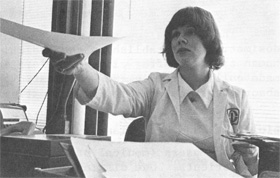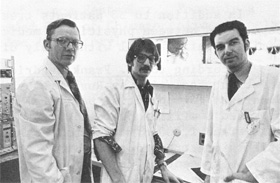Cancer Therapy Facility: The First Six Months
On September 7, 1976, Fermilab's Cancer Therapy Facility (CTF) made history when a volunteer cancer patient received a neutron dose treatment.
Since then, CTF activities have attracted world-wide attention. Press reports in newspapers, Time Magazine and other national media have spread the word of Fermilab's "neutrons against cancer" research. The Village Crier has chronicled CTF's progress; this is an update in a continuing series on the expanding role of the CTF.
Dr. Lionel Cohen, CTF department head and a radiation oncologist (tumor specialist) at Michael Reese Hospital, Chicago, says initial results are encouraging. However, he emphasizes the highly experimental nature of the program.
Of 51 patients referred by medical professionals for possible therapy, 45 have entered the program. To date, 38 patients have been irradiated. Most are Illinois residents, but other states represented are Michigan, Wisconsin, Ohio and Virginia. (One patient commutes weekly by airplane from Ohio.)
Most patients have been 40 to 60 years old, with men outnumbering women 3 to l. A 29-year old man is the youngest patient treated; the oldest, a man 77.
About two dozen patients have completed treatment. Fourteen are currently under treatment from one to three times weekly and three have dropped out of the project. Head and neck cancers account for the largest group of patients treated. Other types were abdomen, pancreas, breast, chest, brain, uterus and tissue.
About half of all patients irradiated receive only neutron therapy. Half were referred for a combination of neutron and conventional photon, X-ray, beam therapy. "It is fair to state," Dr. Cohen said, "that reactions have been relatively mild. No untoward or unexpected acute reactions have been observed in any patient treated so far. It is too early to evaluate the tumor response.
"We feel that these patients represent a sufficient number to complete the pilot studies," Dr. Cohen said, "and propose to follow them carefully for the evaluation of late reactions and tumor responses."
Currently the CTF is using about 60 hours per week of linac beam time. Work involving patient treatment takes 222 hours of this time. The CTF facility will add Saturday treatments to the Monday, Tuesday, Friday schedule, perhaps in May. Expanded therapy hours will increase patient throughput -- averaging about 12 persons daily in 24-minute sessions (10 minutes for exposure, 15 for preparation) -- and will also comply with a four-day treatment week required for participation in national neutron cancer treatment studies.
Most patients are irradiated while sitting in a specially-designed mobile chair that is lowered to the neutron beam line, a floor below the reception area. However, a thigh tumor was treated in the standing position without difficulty. In a colon tumor case, the patient's pelvis was irradiated with the patient lying down on a specially constructed litter attached to the chair base.
The clinical operation is supported by an extensive support program: beam physics; dosimetry and establishing the radiation distribution using a chemical substitute for human tissue. After clinical priorities, the major effort has been to build custom-made collimators--cement and plastic particle gun barrel-type guides that direct and absorb neutrons -- for individual patients.
A third priority is the continuation of radiobiological studies on both microbiological and mammalian systems.
Many users (medical professionals referring patients) have visited and observed their patients. One distinguished visitor last year was physicist David K. Bewley of London's Hammersmith Hospital, where neutron irradiation for cancer has been used since the 1960's. While at Fermilab, Dr. Bewley provided valuable input toward streamlining the CTF operation. The office guest book also records visitors from France, Switzerland (including CERN) and Japan.
In addition to 38 patients treated, CTF's other success story is one of cooperation -- cooperation between physicians, medical physicists, radiation therapy technologists and Fermilab staffers, all with widely diversified specialties.
According to Dr. Frank Hendrickson, CTF deputy head for medical affairs and a radiation oncologist at Rush-Presbyterian St. Luke's Hospital, Chicago, Fermilab offers advantages for potential patients and the advancement of scientific knowledge. Of an estimated 8 million people in the metropolitan area, about 11,000 annually are cancer victims and 1,000 of these may be suitable for research at Fermilab. Typically, after patients are treated at CTF they then return to work, their homes or travel accommodations. Its central location, with auto, train and plane transportation facilities readily accessible make Fermilab convenient to many patients.
Of about 40 referring physicians, about a dozen have volunteered services in the clinic. Volunteers have supervised treatment, examined patients on treatment, noted responses and reactions and dictated clinical notes. "This has been an invaluable aid" Dr. Cohen said, "and made it possible for Dr. Hendrickson and myself to continue the operation at the maximum capacity."
Medical professionals volunteering include: Dr. William Brand and Dr. Stanley Hoover, Northwestern Memorial Hospital, Chicago; Dr. T.C. Chiang, Michael Reese Hospital, Chicago; Dr. Frank Hussey, Jr., Lutheran General Hospital, Chicago; and Dr. Raphael Garces and Dr. Richard Renn, Evanston Hospital.
Non-medical volunteers are: Jordan Finstein, computer department; Duane Voy, radiation physics; Danny Spelbring, Northwestern University graduate student on experiments 305/397; and Allan Halline, a Bucknell University undergraduate who assisted last month.
CTF staff members, in addition to Drs. Cohen and Hendrickson, are: Miguel Awschalom, Ph.D. physicist, deputy department head; Don Young, Ph.D. physicist, associate department head; Ivan Rosenberg, Ph.D. medical physicist; Mrs. JoAnne Mansell, R.N., protocol nurse; Kathy Gehl, administrative assistant; and Alan Jones, operations technologist.





